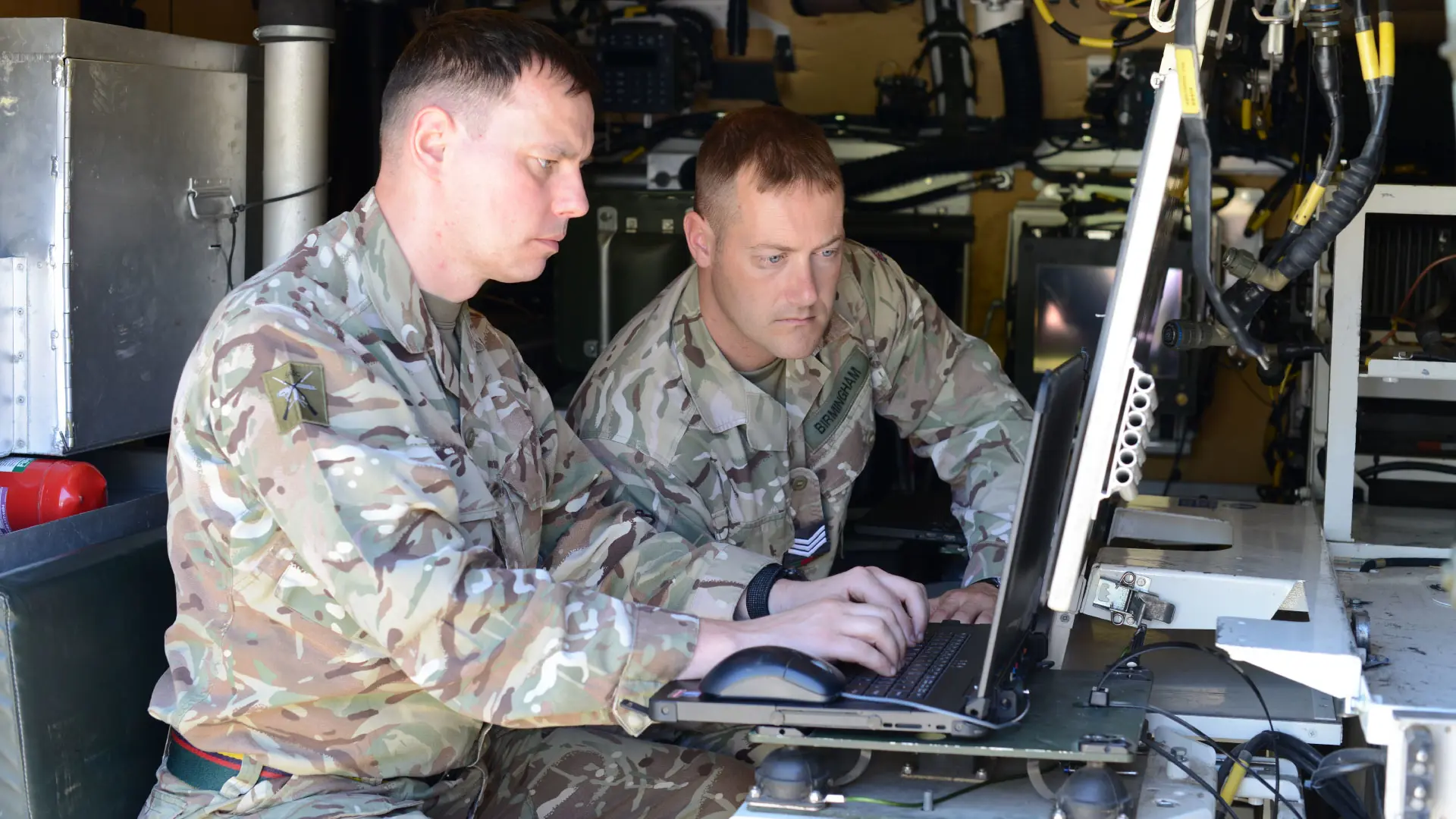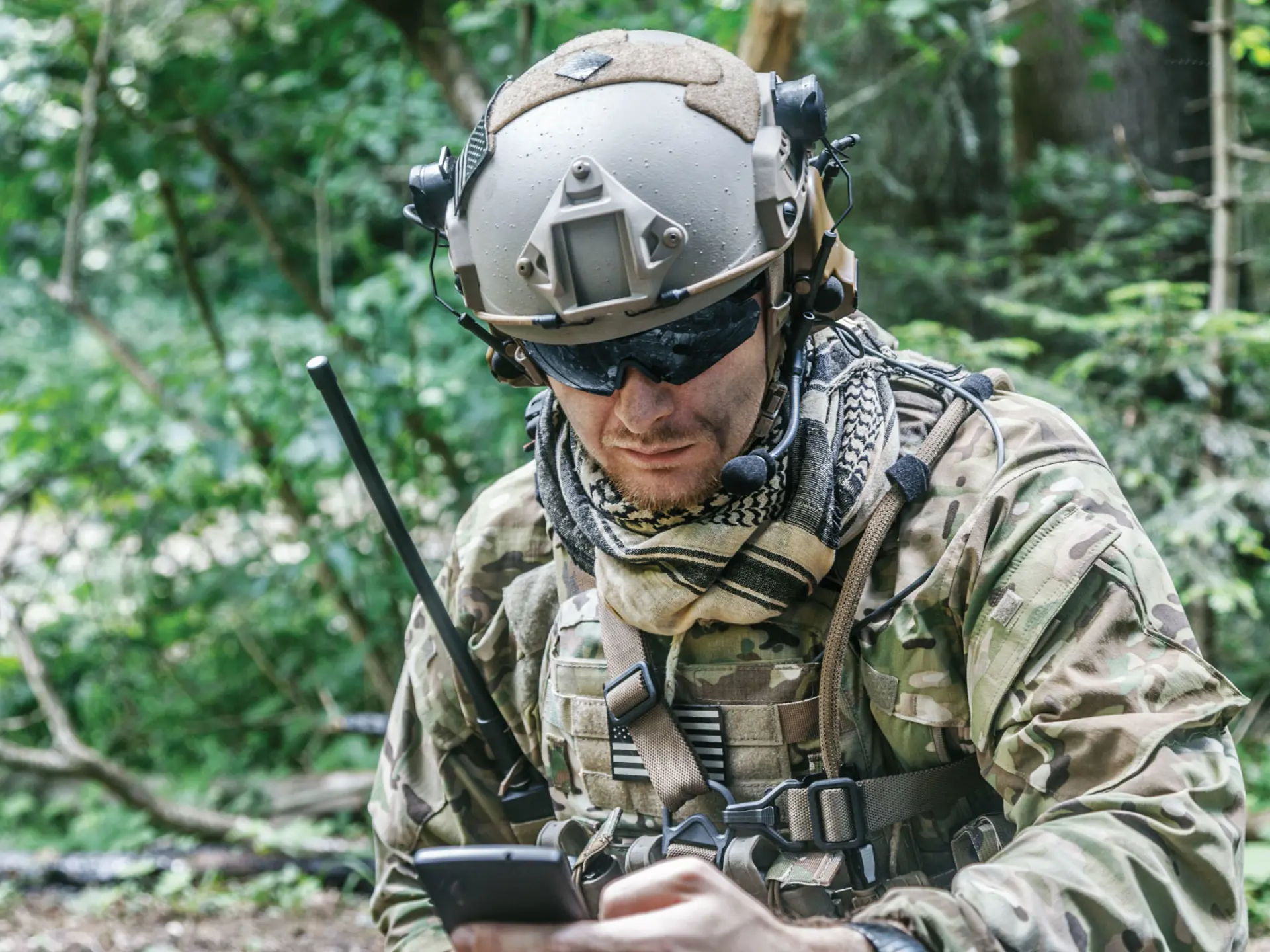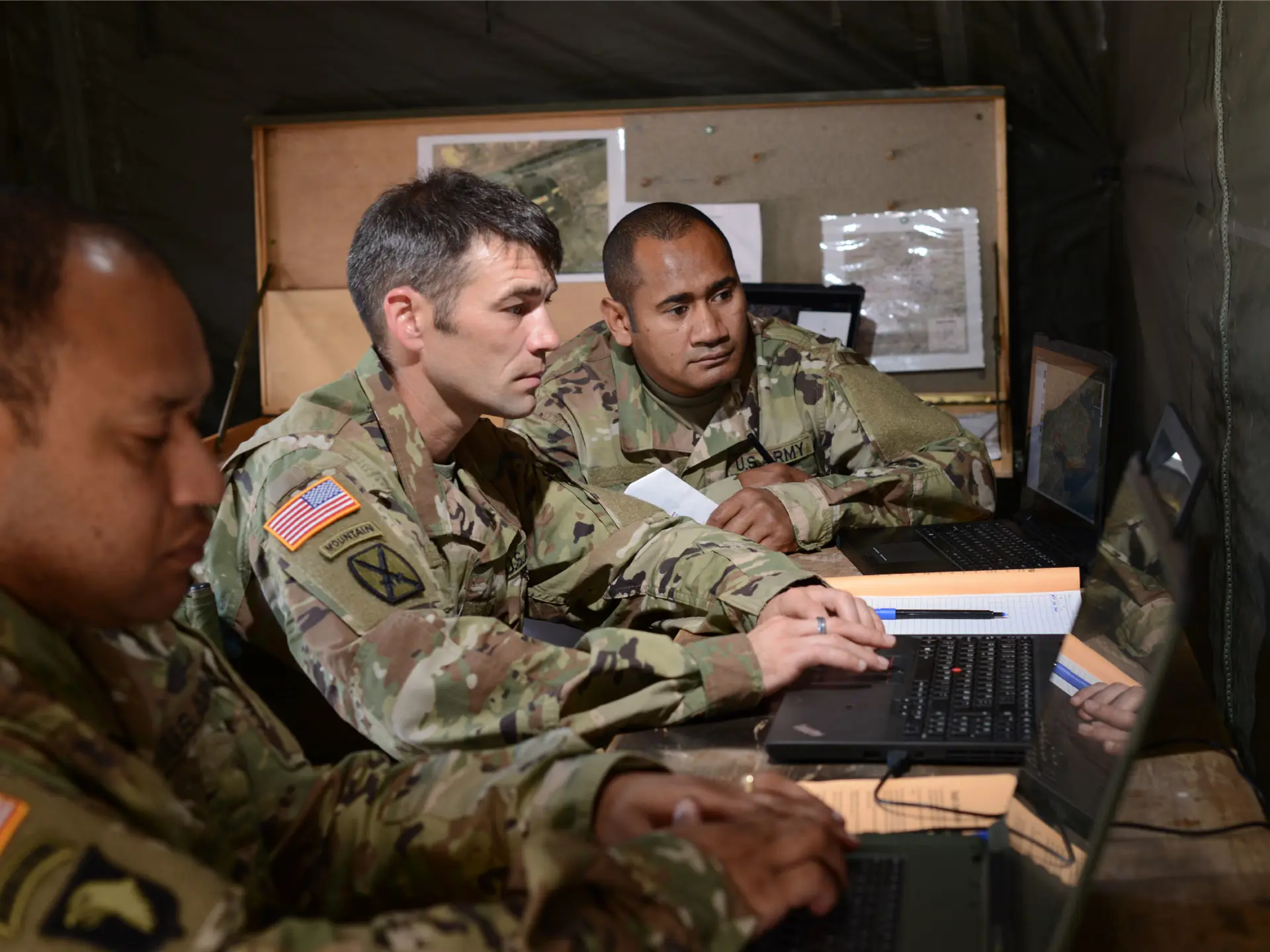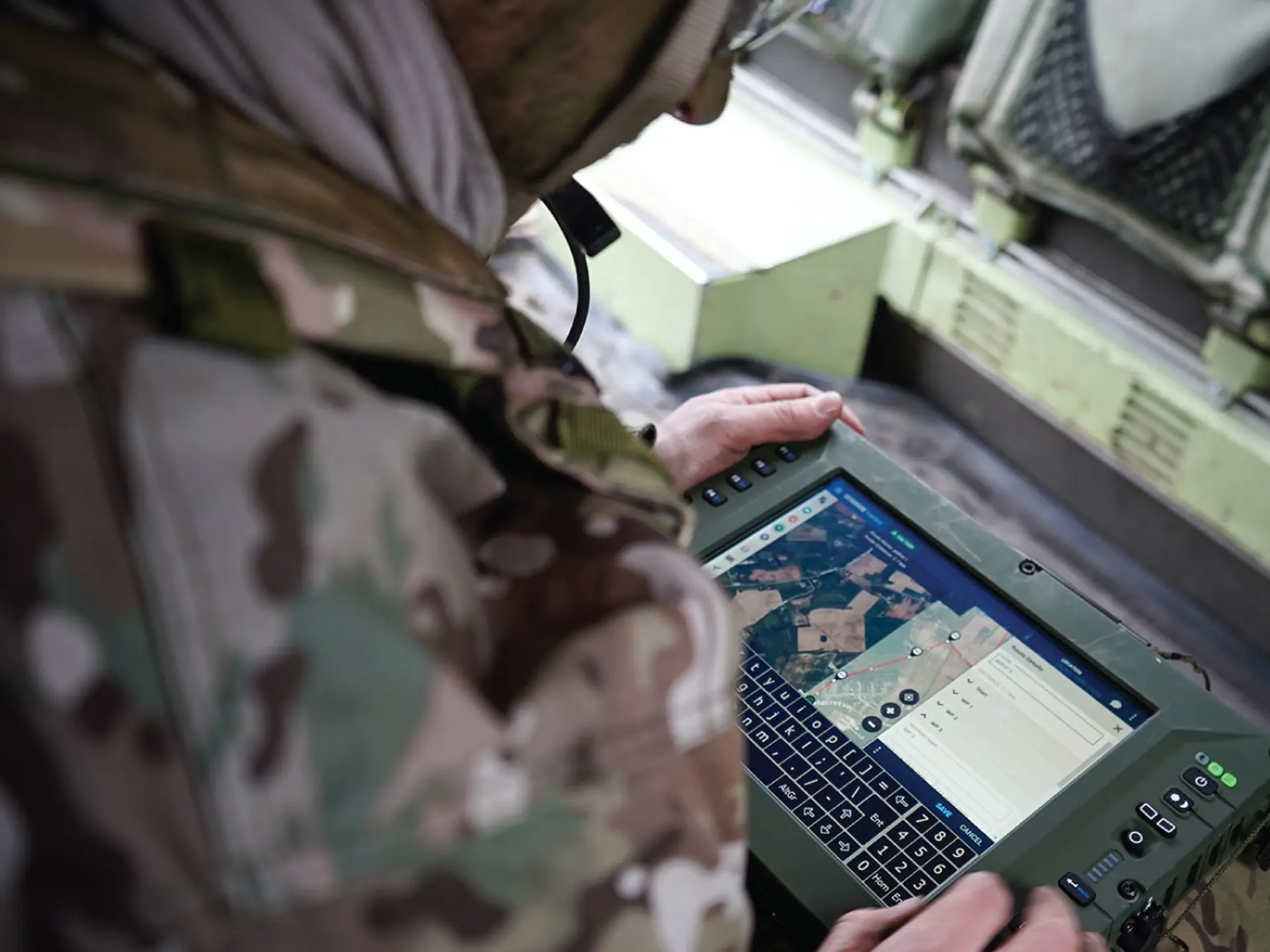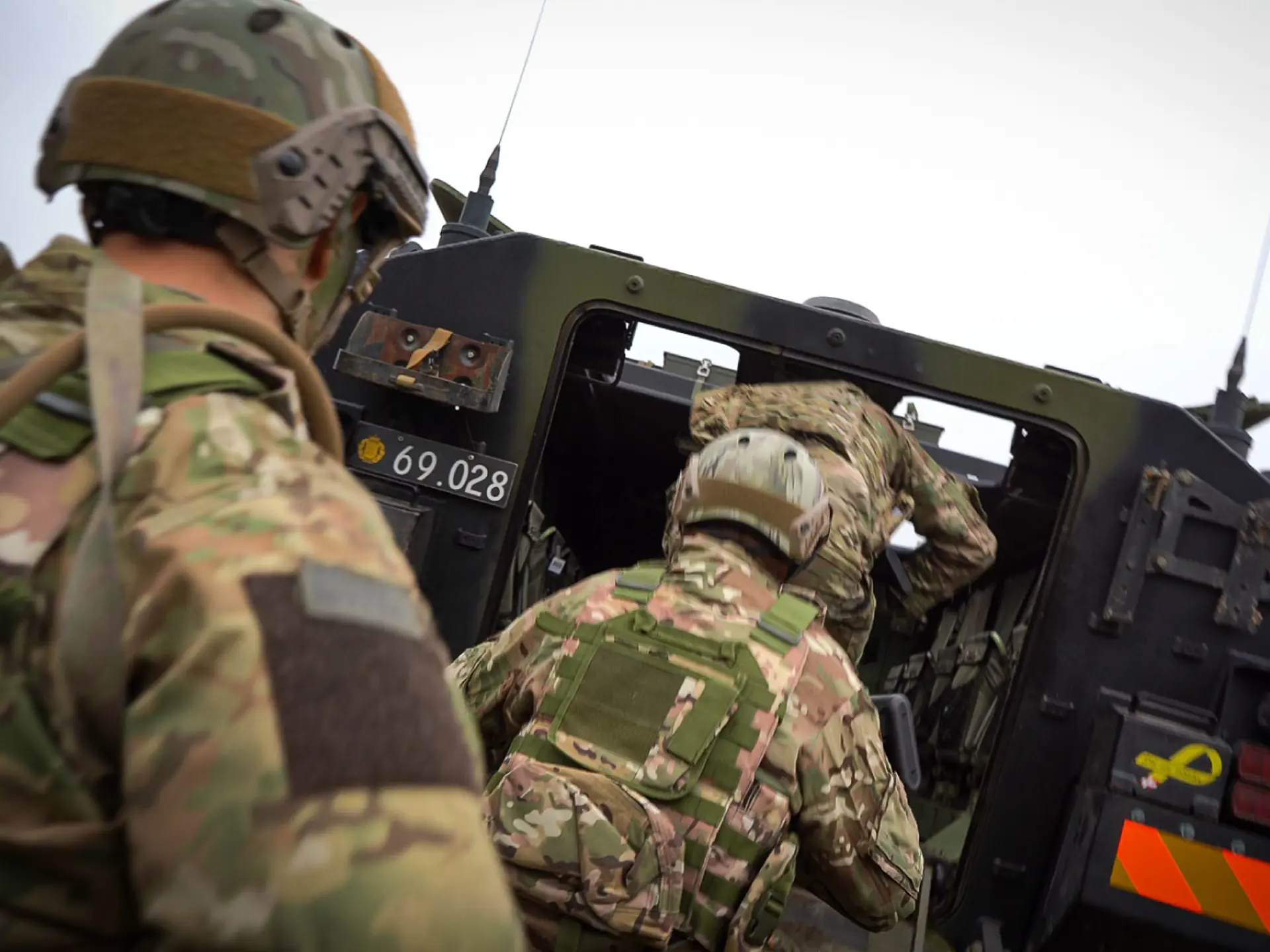The Multilateral Interoperability Programme (MIP) is a community of interest that develops technical specifications, also known as the 'MIP Solution', for multinational interoperability between Command & Control Information Systems (C2IS), primarily for land usage although Joint aspects are also taken into consideration. The MIP solution is especially suitable for the exchange of complex recognized pictures (RPs), the common operational picture (COP), and plans & orders.
To ensure interoperability with virtually any MIP-enabled coalition partner, MIP constitutes an integral part of SitaWare Headquarters. Although the major MIP baselines are not directly inter-version compatible, SitaWare Headquarters provides bridging between MIP Baseline 3.1 and MIP 4.3+.
MIP Baselines
MIP’s approach to structuring complex information
The latest MIP baseline, MIP 4, provides a flexible information grouping through the establishment of Topics.
MIP Baseline 2 throughout MIP Baseline 3.1 provide information grouping of RPs and COPs in terms of predefined Operational Information Groups (OIGs). In the OIG concept, information is categorised into one of six predefined OIG types which are:
- Friendly and Neutral Organisation (FRDNEU) OIG is intended for exchanging information about friendly and neutral units, including their holdings.
- Friendly and Neutral Non-Organisation (FRNENO) OIG is intended for exchanging information about friendly and neutral facilities (e.g. hospitals and harbours) as well as features (e.g. phase lines and supply routes).
- Un-correlated Enemy and Unknown (UNCORR) OIG is intended for exchanging ‘raw’ information (i.e. spot reports) about enemy, suspect or unknown activities.
- Correlated Enemy and Unknown (CORENU) OIG is intended for exchanging information about the processed intelligence picture.
- Globally Significant (GLBSGN) OIG is intended for exchanging information about elements such as minefields and contaminated areas that have a general effect on anyone and do not discriminate between friends, neutrals or enemies.
As for Plans & Orders, these are grouped as follow:
- In MIP Baseline 2 as Composed (Single) Plan (COMPLN) OIG, supporting Plan/Order header and a single overlay.
- In MIP Baseline 3.0 and 3.1 as Plan/Order (PLNORD) OIG, also supporting textual elements, Task Organisation and multiple overlays and sub-overlays.
MIP Baselines Timeline
MIP 4 – From 2020 annually updated in backwards compatible increments
MIP 4 is a radical change to the previous MIP baselines. Where previous baselines were based on a monolithic Information Exchange Data Models (IEDMs) and on a single and huge database-to-database-replication interface, MIP 4 is based on numerous small interfaces, using web services.
As an Entity/Relationship model for direct implementation, the IEDM of the previous MIP baseline (3.1) has been transformed into an object-oriented reference model, MIP Information Model (MIM). Based on operational requirements, MIM evolves constantly, supporting a steadily increasing amount of operational capabilities, in terms of information classes.
MIP 4 Information Exchange Specification (IES) specifies the MIP 4 interfaces. For each interface, the specification is specified by extracting relevant information classes from the MIM and subsequently generating Extended Markup Language (XML) schema definitions (XSDs). When implementing a MIP 4 gateway, vendors of national C2ISs only need to deal with the specific interfaces (XSDs) and not the entire MIM. Compared to previous MIP baselines where vendors were forced to take the entire IEDMs into account, MIP 4 provides a clear potential of effort and cost savings when implementing the gateways. Furthermore, by supporting small individual interfaces (instead of a huge one), coalition partners, employing different C2IS that perhaps do not fully overlap in terms of capabilities, have better opportunities in clarifying and matching the exact level of interoperability.
A key requirement of MIP 4 is backwards compatibility between its increments. This too is a clear improvement from the previous MIP baselines. Specifically, from MIP 4.3, future increments (e.g. MIP 4.5) will be backwards compatible.
The information exchange mechanism of MIP 4 adheres to ADatP-5644 Web Service Messaging Profile (WSMP). WSMP is intended as an information exchange mechanism for all web service-based interoperability standards. Hereby, interoperability standards may share the same exchange mechanism. This will lead to increased reliability, ease of information management, and security.
MIP Baseline 3.1 – Released 2012
As an Entity/Relationship structured domain model, Joint Consultation, Command & Control Information Exchange Data Model 3.1.4 (JC3IEDM 3.1.4) constitutes the core of MIP Baseline 3.1.
JC3IEDM 3.1.4 has been ratified under NATO STANAG 5525, superseding the MIP Baseline 3.0 equivalent version, JC3IEDM 3.0.2. Compared to JC3IEDM 3.0.2, JC3IEDM 3.1.4 has undergone restructurings and enhancements. For symbology standards, mapping rules between JC3IEDM 3.1.4 and the US symbol standard MIL-STD-2525C have also been specified.
As an information exchange mechanism, MIP Baseline 3.1 uses database-to-database replication in the shape of MIP Data Exchange Mechanism (DEM).
The operational requirements, leading to MIP Baseline 3.1, were mainly based on experiences from NATO operations in Afghanistan and Iraq. Thus, MIP Baseline 3.1 provides an extensive support for information exchange about Improvised Explosive Devices (IEDs) and irregular actors. Based on the experiences from the lengthy missions in Afghanistan where a significant amount of MIP information was accumulated over years of operations, the DEM has also been improved to handle this, compared to the previous MIP baselines.
Although superseded by MIP 4.3, MIP Baseline 3.1 is still in widespread operational use.
MIP Baseline 3.0 – Released 2009
As an Entity/Relationship (E/R) structured domain model, Joint Consultation, Command & Control Information Exchange Data Model 3.0.2 (JC3IEDM 3.0.2) constitutes the core of MIP Baseline 3.0.
As an information exchange mechanism, MIP Baseline 3.0 uses database-to-database replication in the shape of MIP Data Exchange Mechanism (DEM). In MIP Baseline 3.0, the supplementary Message Exchange Mechanism (MEM) of the previous baselines was abandoned.
JC3IEDM 3.0.2 was ratified under NATO STANAG 5525, superseding the MIP Baseline 2 equivalent version, Command & Control Information Exchange Model 6.15e (C2IEDM 6.15e). Compared to C2IEDM 6.15e, JC3IEDM 3.0.2 has undergone significant restructuring and enhancements in supporting Plans & Orders, in incorporating Joint elements and in supporting multiple overlays for each OIG.
MIP Baseline 3.0 is no longer in operational use.
MIP Baseline 2 – Released 2006
As an Entity/Relationship (E/R) structured domain model, Command & Control Information Exchange Model 6.15e (C2IEDM 6.15e) constitutes the core of MIP Baseline 2.
As an information exchange mechanism, MIP Baseline 2 uses database-to-database replication in the shape of MIP Data Exchange Mechanism (DEM). As a supplement to the DEM, MIP Baseline 2 specifies Message Exchange Mechanism (MEM) for exchange of point-to-point messages.
MIP Baseline 2 is no longer in operational use.
MIP Baseline 1 – Released 2003
When MIP started the development of Baseline 1, it was being merged with the Army Tactical Command & Control System (ATCCIS) interoperability programme that had existed since 1980. MIP adopted the Entity/Relationship (E/R) ATCCIS data model and renamed it to Land Command & Control Information Exchange Data Model (LC2IEDM).
The ATCCIS Replication Mechanism (ARM) was used as the starting point for MIP’s later released Data Exchange Mechanism (DEM). As an alternative to the ARM, MIP Baseline 1 specifies the Message Exchange Mechanism (MEM). The intention of having two exchange mechanisms was that the DEM would be used for passing near-real time situation awareness information whereas the MEM would be used for distributing less time critical information as formatted messages, conforming to ADatP-3.
MIP Baseline 1 is obsolete and is no longer in use.
Explore
If you're looking for cases, news and downloads, please visit the News & Knowledge section.
News & Knowledge
Newsletter
MIP Baselines
Approach
MIP’s approach to structuring complex information
The latest MIP baseline, MIP 4, provides a flexible information grouping through the establishment of Topics.
MIP Baseline 2 throughout MIP Baseline 3.1 provide information grouping of RPs and COPs in terms of predefined Operational Information Groups (OIGs). In the OIG concept, information is categorised into one of six predefined OIG types which are:
- Friendly and Neutral Organisation (FRDNEU) OIG is intended for exchanging information about friendly and neutral units, including their holdings.
- Friendly and Neutral Non-Organisation (FRNENO) OIG is intended for exchanging information about friendly and neutral facilities (e.g. hospitals and harbours) as well as features (e.g. phase lines and supply routes).
- Un-correlated Enemy and Unknown (UNCORR) OIG is intended for exchanging ‘raw’ information (i.e. spot reports) about enemy, suspect or unknown activities.
- Correlated Enemy and Unknown (CORENU) OIG is intended for exchanging information about the processed intelligence picture.
- Globally Significant (GLBSGN) OIG is intended for exchanging information about elements such as minefields and contaminated areas that have a general effect on anyone and do not discriminate between friends, neutrals or enemies.
As for Plans & Orders, these are grouped as follow:
- In MIP Baseline 2 as Composed (Single) Plan (COMPLN) OIG, supporting Plan/Order header and a single overlay.
- In MIP Baseline 3.0 and 3.1 as Plan/Order (PLNORD) OIG, also supporting textual elements, Task Organisation and multiple overlays and sub-overlays.
MIP Baselines Timeline

MIP Baseline 4
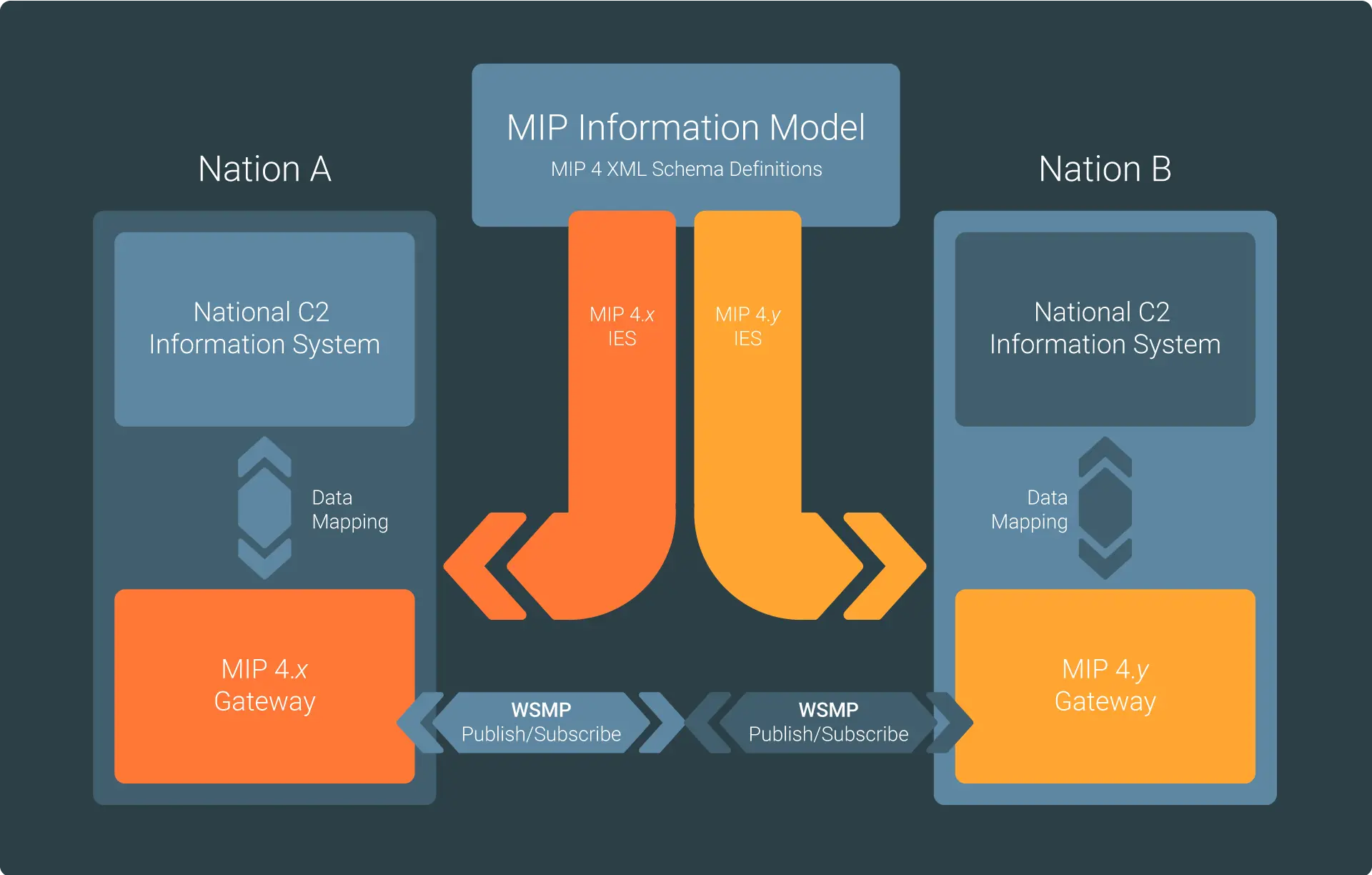
MIP 4 – From 2020 annually updated in backwards compatible increments
MIP 4 is a radical change to the previous MIP baselines. Where previous baselines were based on a monolithic Information Exchange Data Models (IEDMs) and on a single and huge database-to-database-replication interface, MIP 4 is based on numerous small interfaces, using web services.
As an Entity/Relationship model for direct implementation, the IEDM of the previous MIP baseline (3.1) has been transformed into an object-oriented reference model, MIP Information Model (MIM). Based on operational requirements, MIM evolves constantly, supporting a steadily increasing amount of operational capabilities, in terms of information classes.
MIP 4 Information Exchange Specification (IES) specifies the MIP 4 interfaces. For each interface, the specification is specified by extracting relevant information classes from the MIM and subsequently generating Extended Markup Language (XML) schema definitions (XSDs). When implementing a MIP 4 gateway, vendors of national C2ISs only need to deal with the specific interfaces (XSDs) and not the entire MIM. Compared to previous MIP baselines where vendors were forced to take the entire IEDMs into account, MIP 4 provides a clear potential of effort and cost savings when implementing the gateways. Furthermore, by supporting small individual interfaces (instead of a huge one), coalition partners, employing different C2IS that perhaps do not fully overlap in terms of capabilities, have better opportunities in clarifying and matching the exact level of interoperability.
A key requirement of MIP 4 is backwards compatibility between its increments. This too is a clear improvement from the previous MIP baselines. Specifically, from MIP 4.3, future increments (e.g. MIP 4.5) will be backwards compatible.
The information exchange mechanism of MIP 4 adheres to ADatP-5644 Web Service Messaging Profile (WSMP). WSMP is intended as an information exchange mechanism for all web service-based interoperability standards. Hereby, interoperability standards may share the same exchange mechanism. This will lead to increased reliability, ease of information management, and security.
MIP Baseline 3.1
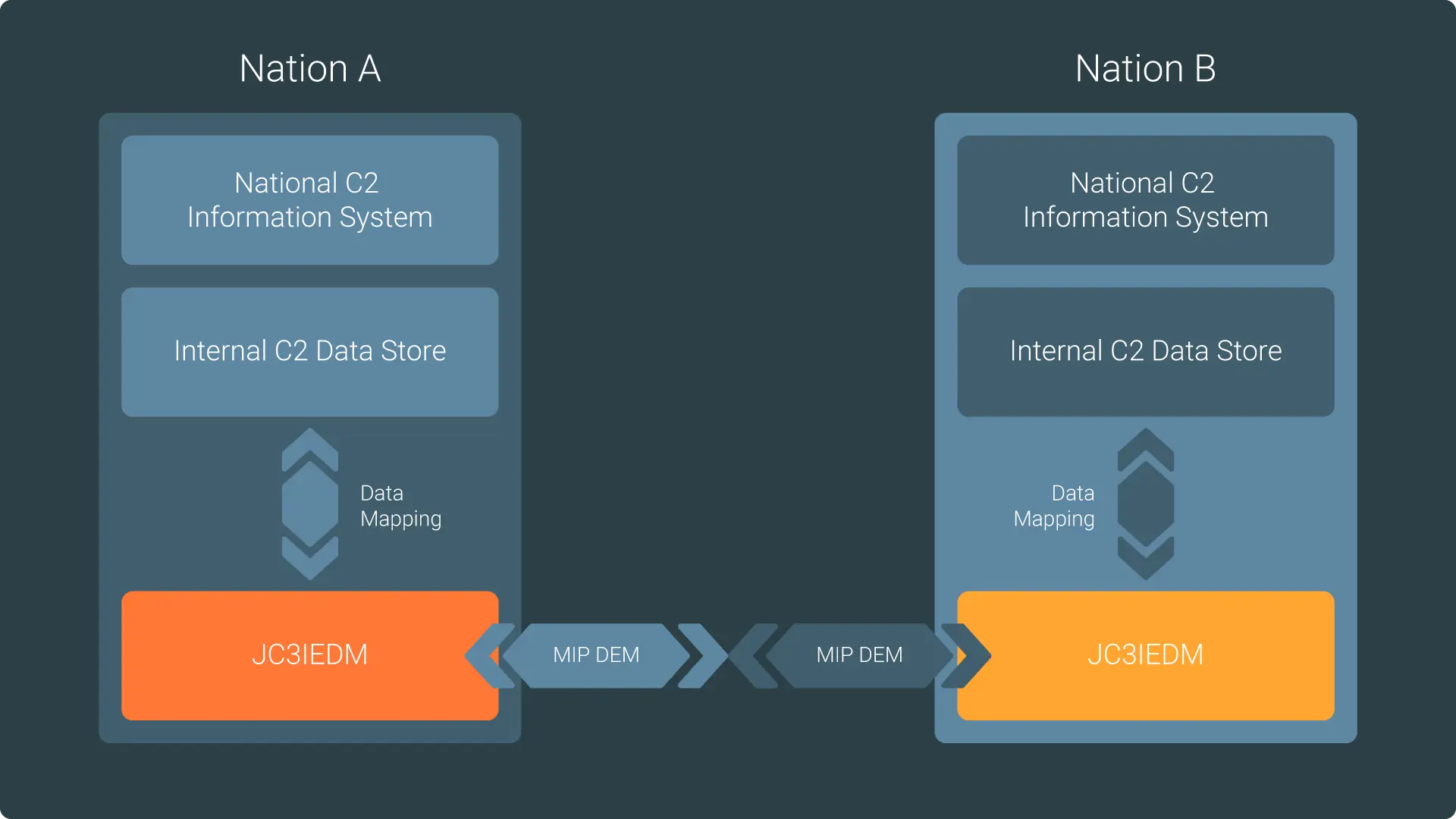
MIP Baseline 3.1 – Released 2012
As an Entity/Relationship structured domain model, Joint Consultation, Command & Control Information Exchange Data Model 3.1.4 (JC3IEDM 3.1.4) constitutes the core of MIP Baseline 3.1.
JC3IEDM 3.1.4 has been ratified under NATO STANAG 5525, superseding the MIP Baseline 3.0 equivalent version, JC3IEDM 3.0.2. Compared to JC3IEDM 3.0.2, JC3IEDM 3.1.4 has undergone restructurings and enhancements. For symbology standards, mapping rules between JC3IEDM 3.1.4 and the US symbol standard MIL-STD-2525C have also been specified.
As an information exchange mechanism, MIP Baseline 3.1 uses database-to-database replication in the shape of MIP Data Exchange Mechanism (DEM).
The operational requirements, leading to MIP Baseline 3.1, were mainly based on experiences from NATO operations in Afghanistan and Iraq. Thus, MIP Baseline 3.1 provides an extensive support for information exchange about Improvised Explosive Devices (IEDs) and irregular actors. Based on the experiences from the lengthy missions in Afghanistan where a significant amount of MIP information was accumulated over years of operations, the DEM has also been improved to handle this, compared to the previous MIP baselines.
Although superseded by MIP 4.3, MIP Baseline 3.1 is still in widespread operational use.
MIP Baseline 3.0
MIP Baseline 3.0 – Released 2009
As an Entity/Relationship (E/R) structured domain model, Joint Consultation, Command & Control Information Exchange Data Model 3.0.2 (JC3IEDM 3.0.2) constitutes the core of MIP Baseline 3.0.
As an information exchange mechanism, MIP Baseline 3.0 uses database-to-database replication in the shape of MIP Data Exchange Mechanism (DEM). In MIP Baseline 3.0, the supplementary Message Exchange Mechanism (MEM) of the previous baselines was abandoned.
JC3IEDM 3.0.2 was ratified under NATO STANAG 5525, superseding the MIP Baseline 2 equivalent version, Command & Control Information Exchange Model 6.15e (C2IEDM 6.15e). Compared to C2IEDM 6.15e, JC3IEDM 3.0.2 has undergone significant restructuring and enhancements in supporting Plans & Orders, in incorporating Joint elements and in supporting multiple overlays for each OIG.
MIP Baseline 3.0 is no longer in operational use.
MIP Baseline 2
MIP Baseline 2 – Released 2006
As an Entity/Relationship (E/R) structured domain model, Command & Control Information Exchange Model 6.15e (C2IEDM 6.15e) constitutes the core of MIP Baseline 2.
As an information exchange mechanism, MIP Baseline 2 uses database-to-database replication in the shape of MIP Data Exchange Mechanism (DEM). As a supplement to the DEM, MIP Baseline 2 specifies Message Exchange Mechanism (MEM) for exchange of point-to-point messages.
MIP Baseline 2 is no longer in operational use.
MIP Baseline 1
MIP Baseline 1 – Released 2003
When MIP started the development of Baseline 1, it was being merged with the Army Tactical Command & Control System (ATCCIS) interoperability programme that had existed since 1980. MIP adopted the Entity/Relationship (E/R) ATCCIS data model and renamed it to Land Command & Control Information Exchange Data Model (LC2IEDM).
The ATCCIS Replication Mechanism (ARM) was used as the starting point for MIP’s later released Data Exchange Mechanism (DEM). As an alternative to the ARM, MIP Baseline 1 specifies the Message Exchange Mechanism (MEM). The intention of having two exchange mechanisms was that the DEM would be used for passing near-real time situation awareness information whereas the MEM would be used for distributing less time critical information as formatted messages, conforming to ADatP-3.
MIP Baseline 1 is obsolete and is no longer in use.

